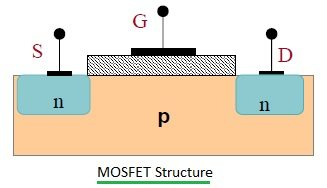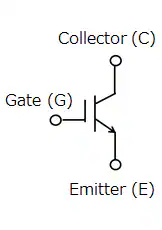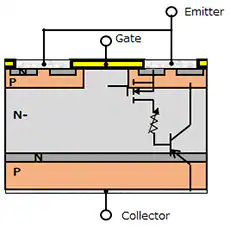What are IGBT and MOSFET?
In the realm of electronic components, IGBT (Insulated Gate Bipolar Transistor) and MOSFET (Metal-Oxide-Semiconductor Field-Effect Transistor) are seminal devices. As we delve into the world of these crucial devices, we must first comprehend their inherent nature, their raison d'être in the world of electronics, and the pivotal role they play in countless applications.
Understanding the MOSFET: Origin, Structure, and Function
MOSFET, an acronym that resonates with its complex structure and function, is the cornerstone of modern electronic devices. Its journey began in the mid-20th century, a time ripe with electronic innovation. It is a four-terminal device with Source (S), Drain (D), Gate (G), and body (B) terminals. The body (B) is frequently connected to the source terminal, reducing the terminals to three. However, the essence of the MOSFET lies in its operation, as it uses an electric field to regulate the conductivity of a semiconductor, a property intrinsic to its name.

Decoding the IGBT: Origin, Structure, and Function
The IGBT is a more recent entrant into the electronics arena. In essence, it is a hybrid of two fundamental electronic devices - the bipolar junction transistor (BJT) and the MOSFET. The IGBT marries the high input impedance of the MOSFET with the low saturation voltage of the BJT. Consequently, it provides an optimized solution for high voltage and high current applications.


Symbol of an N-channel IGBT (left) and Typical IGBT structure (right)
MOSFET: Advantages and Disadvantages
The MOSFET is renowned for its high switching speed and low on-resistance, properties that make it the transistor of choice in applications such as switching power supplies and motor drives. However, it is not without its shortcomings. High-power MOSFETs are susceptible to thermal runaway, a phenomenon that can lead to catastrophic failure.
IGBT: Advantages and Disadvantages
The IGBT, on the other hand, exhibits superior performance in high voltage applications due to its lower saturation voltage. Furthermore, it is less prone to thermal runaway. Nonetheless, the IGBT is not without its Achilles heel. It has a slower switching speed compared to the MOSFET, which can be a limiting factor in high-frequency applications.
MOSFET vs. IGBT
When juxtaposing the MOSFET and the IGBT, one realizes that the choice between the two boils down to the specifics of the application at hand. Both devices have their unique strengths and weaknesses. Therefore, an understanding of the application requirements is paramount in making the right choice.
MOSFET vs IGBTParameter | IGBT | MOSFET |
|---|
Operating Voltage | Can work in high voltage applications, generally over 600V, and can reach several thousand volts maximum. | Work in low voltage applications, generally below 200V, up to hundreds of volts |
Switching speed | The switching speed is relatively slow, so it is not suitable for high frequency applications. | Fast switching speed and therefore suitable for high-frequency applications |
On-resistance | At high currents, the on-resistance is low, but at low currents, the on-resistance is high. | MOSFET on-resistance is independent of current, so it is more advantageous in low current applications |
Switching losses | Switching losses are relatively high. | relatively low switching losses |
Robustness | More robust to short circuit and overvoltage conditions. | Less robust to short circuits and overvoltages |
Drive circuit complexity | In high voltage applications, more complex drive circuits than MOSFETs are usually required. | The drive circuit is relatively simple |
Output characteristics | In the saturation region, the current of the IGBT will level off with increasing voltage, which makes it easier to drive. | MOSFET's current will increase with voltage, which makes it more careful to drive |
Failure mode | The failure mode of an IGBT is usually open circuit, which makes it safer in case of failure. | The failure mode of a MOSFET is usually a short circuit, which can lead to damage to the power supply or load |
Cost | An IGBT is generally more expensive than a MOSFET, but it can handle higher currents and voltages, making it more economical in high power applications. | MOSFETs are generally less expensive than IGBTs, but in high voltage and high current applications multiple devices may need to be connected in parallel, which can add cost |
Key Factors to Consider when Choosing between MOSFET and IGBT
It is essential to consider factors such as the required switching speed, the operating voltage, the load current, and the thermal management capabilities of the system when deciding between the MOSFET and the IGBT.
Practical Applications of MOSFET
From the humble laptop charger to the complex power supply units of supercomputers, the MOSFET finds a place in a plethora of applications. The key to its ubiquitous presence lies in its versatile nature and high-speed switching capabilities.
Switching applications: Due to their fast switching speed and low on-resistance, MOSFETs are widely used in switching power supplies such as switching power converters (SMPS) and DC-DC converters. Additionally, they are used in switching applications in motor drives and battery management systems.
Amplifiers: MOSFETs are widely used in amplifiers due to their high input impedance. They are used in radio frequency (RF) amplifiers, such as wireless communication equipment, and audio amplifiers, such as home audio systems and electronic musical instruments.
Digital Logic Circuits: MOSFETs are the basis of digital logic circuits such as computer processors, memory devices and other digital systems. CMOS (Complementary Metal-Oxide Semiconductor) technology uses N-type and P-type MOSFETs and provides the basis for most modern digital integrated circuits.
Electric and hybrid vehicles: In the drive systems of these vehicles, MOSFETs are used for battery management and motor control. Due to their fast switching speed and high efficiency, they are essential to enable high-performance and efficient electric vehicles.
Power Management: In laptops, servers, power adapters, etc., MOSFETs are used to achieve efficient power management. By using MOSFETs in the power conversion process, energy loss can be reduced and system efficiency can be improved.
RF applications: In communication equipment such as mobile phones, wireless routers, etc., MOSFETs are used to achieve RF power amplification. They play an important role in the transmission and reception of radio frequency signals.
Practical Applications of IGBT
The IGBT shines in high-power applications such as electric vehicle motor drives and renewable energy inverters. The characteristics of the IGBT make it an ideal candidate for these demanding applications.
Inverter: IGBT is usually used for motor drive and speed regulation. In motor drive systems such as elevators, fans, water pumps, and electric tools, IGBTs are used in frequency converters to control the speed and torque of the motor.
Electric vehicles and hybrid vehicles: IGBTs are used in the traction inverters of these vehicles to drive the electric motors. In addition, it is also used in battery charging systems, and other high-efficiency, high-frequency power conversion applications.
Power grid: IGBTs are used in power transformers and power electronics systems such as high voltage direct current transmission (HVDC) systems and flexible alternating current transmission (FACTS) systems. In addition, it is also used in power supply equipment such as switching power supplies and uninterruptible power supplies (UPS).
Renewable energy: In solar and wind energy systems, IGBTs are used in inverters to convert direct current into alternating current for use in the power grid.
Printed circuit board (PCB) drilling: IGBTs are also used in high-speed drilling machines in the PCB manufacturing process, which can provide high-frequency pulses that allow the drilling machine to accurately drill holes in the PCB.
Power tools: Power tools such as chainsaws and electric drills often use IGBTs as part of their power supplies to adjust the speed and power of the tools.
Which is better, IGBT or MOSFET?
The question of whether an Insulated Gate Bipolar Transistor (IGBT) or a Metal-Oxide-Semiconductor Field-Effect Transistor (MOSFET) is "better" depends on the specific application. Both IGBT and MOSFET are types of power electronics devices and are used to control the flow of electrical energy in various applications, but they have different characteristics that make them more suitable for certain uses.
Here are some key points to consider:
1. Voltage Rating: IGBTs are typically used in high voltage applications (above 600V), where they offer better efficiency. MOSFETs, on the other hand, are commonly used in low voltage applications (below 200V) where their lower on-state resistance leads to better efficiency.
2. Switching Speed: MOSFETs generally have faster switching times compared to IGBTs, making them suitable for high-frequency applications. IGBTs have slower switching times, but this is usually not a problem in lower frequency applications.
3. Conduction Losses: IGBTs have higher conduction losses at low currents compared to MOSFETs due to their higher on-state voltage drop. However, at higher current levels, the conduction losses of a MOSFET increase more rapidly than those of an IGBT.
4. Switching Losses: MOSFETs usually have lower switching losses compared to IGBTs. This makes them more efficient in applications with high switching frequencies.
5. Robustness: IGBTs are generally more robust to short-circuit conditions compared to MOSFETs. This makes IGBTs more suitable for applications where robustness is critical.
6. Complexity of Drive Circuitry: IGBTs typically require more complex drive circuitry than MOSFETs, especially in high voltage applications. This can increase the overall cost and complexity of the system.
Conclusion
The choice between an IGBT and a MOSFET depends on the specific requirements of the application, including voltage and current levels, switching frequency, efficiency requirements, and cost considerations.

Nantian Electronics a professional distributor of electronic components, providing a wide range of electronic products, saving you a lot of time, effort and cost through our meticulous order preparation and fast delivery service.
Share this post


